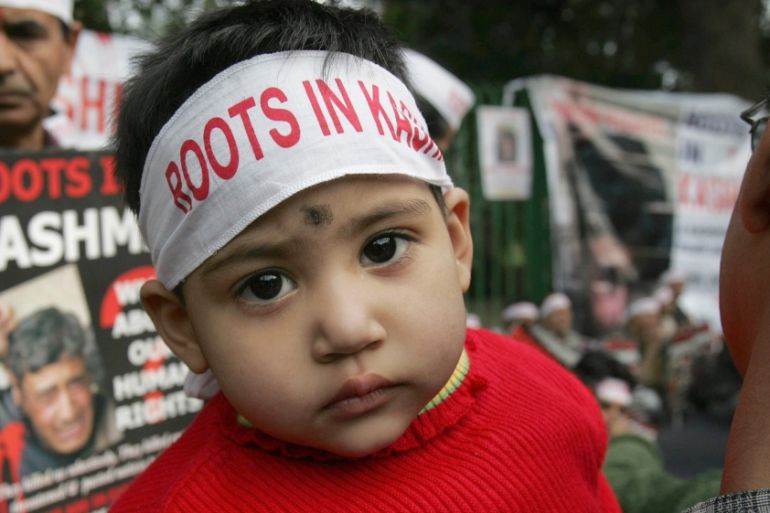Kashmiri Pandits must reimagine the idea of return to Kashmir
The return of the Kashmiri Hindu population which fled in the 1990s should not turn into a colonisation of Kashmir.

The dream of Kashmiri Pandits’ return to their homeland in the Kashmir Valley has surfaced once again with the Indian government’s stealthy abrogation on August 5 of Article 370, the constitutional provision that has secured the autonomous status of Jammu and Kashmir state since India’s independence in 1947. With the associated revocation of Article 35 A, which had allowed the state to define permanent residency, the doors were effectively thrown open for all Indians to buy land in Kashmir.
Across news coverage, after the decision was made, many Kashmiri Pandits – native Brahmin Hindus of the Kashmir Valley – who had left their homes in Kashmir in the 1990s, were seen celebrating. They were hopeful that they could now return “on their own terms”. As one such Pandit said to the BBC: “Our banishment has ended. … Today is the actual independence.”
On social media, many Kashmiri Pandits, including second-generation Pandits with little material connection to Kashmir outside of the occasional vacation and the everlasting nostalgia for their homeland, immediately began to circulate advertisements for land that is for sale in Kashmir. They appeared jubilant in the knowledge that should they plan to “go back” and build homes in Kashmir, they will be supported by the Modi government, which came to power in part by mobilising the dream of Kashmiri Pandits’ return.
Joining in this celebration were many non-Kashmiri nationalistic Hindu men, who also aired their fantasies of buying land in Kashmir, while noting in the same breath their intention to pursue Kashmiri women for good measure. The irony that the removal of 35 A was secured based on an argument against gender discrimination should be lost on no one.
Since a complete communication blackout had been imposed on Kashmir, little is known about how the minority of non-migrant Kashmiri Pandits – who remained in Kashmir through the 1990s – have received the news that their home is now open to settlement by any Indian Hindu who has the necessary financial means.
It is worth asking, then, whether the abrogation of Articles 370 and 35A will ensure the safe return of the more than 100,000 Kashmiri Pandits to the idyllic homes they left behind in the 1990s, on their “own terms”. If those terms entail a return not merely to the territory of Kashmir but to any semblance of the cultural and social relations that had once made Kashmir home, then jubilating Kashmiri Pandits might want to ask whether their native home is being secured or only further eroded by the recent decision.
In a strange twist, the removal of Article 35 A, which was important to Kashmiri Pandits’ own early mobilisation to secure government jobs for themselves from Indians of the plains, may now well turn the erstwhile Kashmiri Pandit native into a settler. Pandits who have nursed dreams of return must know that they will arrive not as neighbours, but as a demographic stick with which to beat local Kashmiri Muslims and pave the way for a settler-colonial project designed to transform India’s only Muslim-majority state into a Hindu-majority one.
One of the most enduring mainstream narratives around the departures of Kashmiri Pandits in the 1990s is that they were “driven out” by their Muslim neighbours as the armed militancy took off. This is a narrative that has displaced every other analysis of these tragic departures, offering up Kashmiri Pandits as singular and exclusive victims in the violent modern history of Kashmir, even as Kashmiri Muslims have in their turn endured violent crackdowns, enforced disappearances, arbitrary detentions, and a general devaluation of every form of political power, including the right to protest their oppressive conditions.
As a result, many advocate for separate colonies for Pandits returning to Kashmir, presumably to secure them from their Kashmiri Muslim neighbours. In this vision of a return home, Pandits would live behind fortified walls and securitised encampments, fearing human contact while willing Kashmiris Muslims out of existence.
Instead of submitting their visions of home to such an order, Kashmiri Pandits everywhere might want to think about how to envision an ethical and dignified return to their homeland that is not built on the notions of segregation, seclusion, and apartheid.
They might want to envision a collective future, in which their sense of security derives from interrelationships with those around them, rather than from a military infrastructure that victimises others while inflating the power of a state that has already shown scant regard for the provisions of constitutional democracy. For there is no pastoral happily-ever-after home waiting for Pandits in Kashmir while their Muslim brethren experience the full might of an occupying Indian state on them.
Any vision of return must respect the multiple histories, identities, and sufferings that have constituted a place and its people for over 70 years. It must also include a willingness to let go of the dominant narratives of exclusive vulnerability that have allowed Kashmiri Pandits to be used as a pawn to endorse India’s slide into Hindu majoritarianism.
Finally, such a vision of home must necessarily be anchored to an imagination of collective social and political justice for all in Kashmir. If Kashmiri Pandits cite the fear of engulfment by Kashmiri Muslims as a reason for a segregated security state, they might also ask why Kashmiri Muslims should be expected to assimilate into a Hindu state that has persistently killed, tortured, and imprisoned them for seeking their UN-sanctioned right of self-determination.
A new dream of home is possible, and the work of imagining it must begin now.
The views expressed in this article are the author’s own and do not necessarily reflect Al Jazeera’s editorial stance.